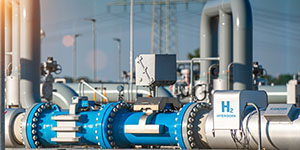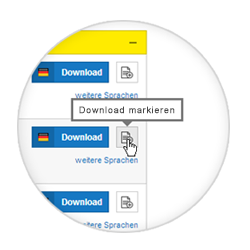Reliable Measurement Technology for Hydrogen – Challenges and Solutions
Why is hydrogen so challenging to measure?
What special chemical properties make hydrogen extremely challenging?
In spite of its simple atomic structure, consisting of just one proton and one electron, hydrogen exhibits complex chemical properties. Especially critical are its:
- High reactivity: Together with oxygen, hydrogen forms highly explosive mixtures – the ignition energy required is 15 times lower than that of methane.
- High diffusivity: Its small molecules can penetrate metallic materials, which could cause leaks. In oil-filled pressure transmitters for example, the gas can migrate into the oil filling inside, causing it to swell.
- Hydrogen embrittlement: Hydrogen also accumulates at grain boundaries in metals, which can lead to weak points and over the long term, even sudden failure.
To meet these challenges, manufacturers of hydrogen measurement technology rely on materials such as 316L stainless steel and innovative special coatings like gold-rhodium.
Why is pressure and level measurement of hydrogen so challenging?
Hydrogen is stored either under very high pressure or at extremely low temperatures. These conditions place considerable stress on the measuring instruments deployed. Hydrogen is often stored at 400 to 700 bar, in high-pressure vessels or compressor systems. The challenge here:
- instruments must withstand extreme pressures without losing accuracy.
- Material fatigue due to hydrogen embrittlement must be prevented.
- Hydrogen diffusion can impair the stability of pressure measuring cells over the long term.
For these applications, VEGA offers robust solutions such as VEGABAR 83, which can measure pressures of up to 1,000 bar. The oil-free metallic measuring cell prevents drift due to hydrogen diffusion, while the gold-rhodium coating provides additional protection.
To reduce volume, hydrogen is also compressed and liquefied and stored in liquid form. For this purpose, the gas is cooled down to -240 to -253 °C. The extreme temperatures pose unique challenges for measurement technology:
- The instruments must be stable in operation at temperatures close to absolute zero.
- The sealing materials must be able to withstand extremely low temperatures without becoming brittle.
- Thermal bridges must be avoided, as even the smallest temperature differences can lead to evaporation.
For these conditions, VEGA customers rely on guided radar instruments from the VEGAFLEX series, which enable reliable level measurement even of media with low dielectric constant values.
What solutions does VEGA offer for hydrogen measurement?
VEGA develops instruments specially tailored to hydrogen applications – these transmitters work reliably, even under extreme conditions. Some of their most important features are:
- CERTEC® measuring cells: These ceramic measuring cells operate without filling oil and therefore have no diffusion and swelling problems.
- Gold-rhodium coatings: These reduce the diffusion of hydrogen into metallic instrument components and prevent material fatigue.
- Temperature and pressure compensation: Ensures precise measured values even in dynamic processes.
- Diffusion-tight sealing systems: Prevents hydrogen leaks through process fittings.
VEGABAR 83 is ideal for industrial use in high-pressure systems, while VEGABAR 82 with its ceramic measuring cell is specifically designed for aggressive media such as potassium hydroxide in electrolysers.
What role does safety play in hydrogen measurement technology?
Safety is a key aspect of hydrogen technology. The explosion range of hydrogen is very wide: A mixture of oxygen or air and hydrogen is highly explosive if there is an H2 concentration of 4 to 77 percent by volume. Furthermore, hydrogen has an extremely low minimum ignition energy. To minimise risks, multi-stage protection concepts are employed:
- Primary explosion protection: Avoidance of explosive mixtures, e.g. through the reliable separation of hydrogen and oxygen in electrolysers.
- Secondary explosion protection: Elimination of ignition sources by using intrinsically safe instruments with low electrical energy.
- Tertiary explosion protection: Measures to limit damage if ignition does occur.
VEGA instruments are certified according to ATEX, IECEx and SIL and enable safe use in potentially explosive atmospheres and in safety-instrumented systems.
How does digitalisation contribute to process safety?
Besides pure measurement, modern instrument technology offers additional digital functions that contribute to operational safety. VEGA instruments feature:
- Self-diagnostic functions: Continuous monitoring of the instrument status to detect anomalies at an early stage.
- Digital data transmission: Seamless integration into Industry 4.0 systems via IO-Link and HART protocols.
- Remote access via Bluetooth: Maintenance and parameterisation from a safe distance.
What is more, VEGA Inventory System enables predictive inventory monitoring to avoid bottlenecks and plan replenishments in a timely manner.
How does VEGA protect its instruments from hacker attacks?
The increasing digitalisation and networking of industrial processes is making industrial process systems more susceptible to cyber attacks. Individual measuring instruments are also being targeted more and more by hackers. Tampering with these devices not only jeopardises data security, but also significantly impairs operational safety. It is therefore vital to protect operational technology (OT), in order to safeguard both production control and the integrity of measuring systems from attacks. VEGA meets these challenges with a comprehensive security concept, which is integrated in VEGAPULS 6X, for example. This radar instrument meets the requirements of IEC 62443-4-2 and, thanks to a multi-level protection approach (Defense-in-Depth), offers reliable protection against data manipulation, espionage and denial-of-service attacks. The most important protective measures include:
- Encrypted data transmission to defend against cyberattacks
- User authentication to prevent unauthorised access
- Firmware integrity checks to ensure that only authorised software updates are carried out
- Event log that documents tampering attempts
Another key element of VEGA’s security strategy is the company’s own Product Security Incident Response Team (PSIRT). This team continuously monitors the security situation, develops preventive updates and responds quickly to potential threats. By combining cybersecurity, functional safety and digital protection mechanisms, VEGA helps ensure that hydrogen plants remain secure even in a networked world.
Conclusion: Precise and safe measurement technology for hydrogen applications
Related industries

Hydrogen
Products
Export this article
Download as PDFShare this article
Comments ({{comments.length}})
{{getCommentAuthor(comment, "Anonymous")}} {{comment.timestamp | date : "dd.MM.yyyy HH:mm" }}
{{comment.comment}}







